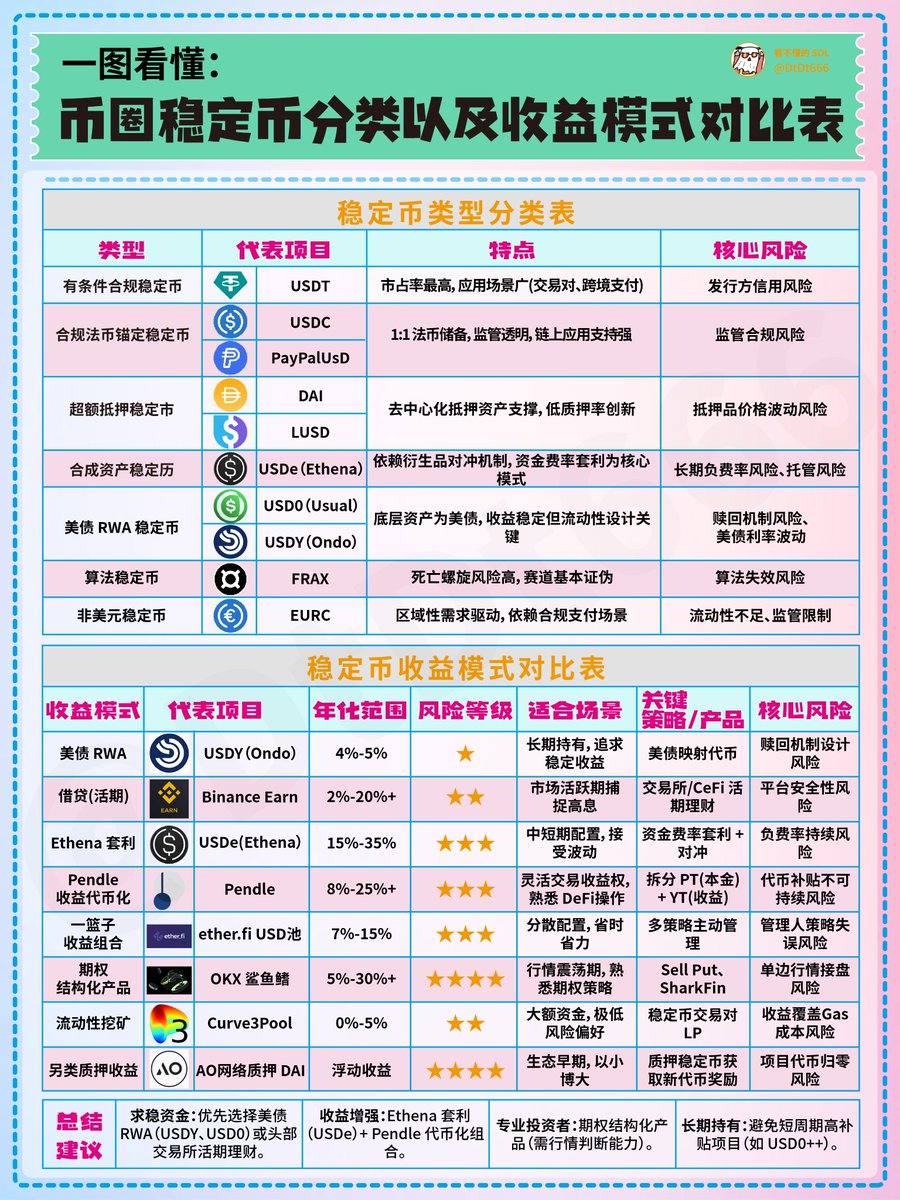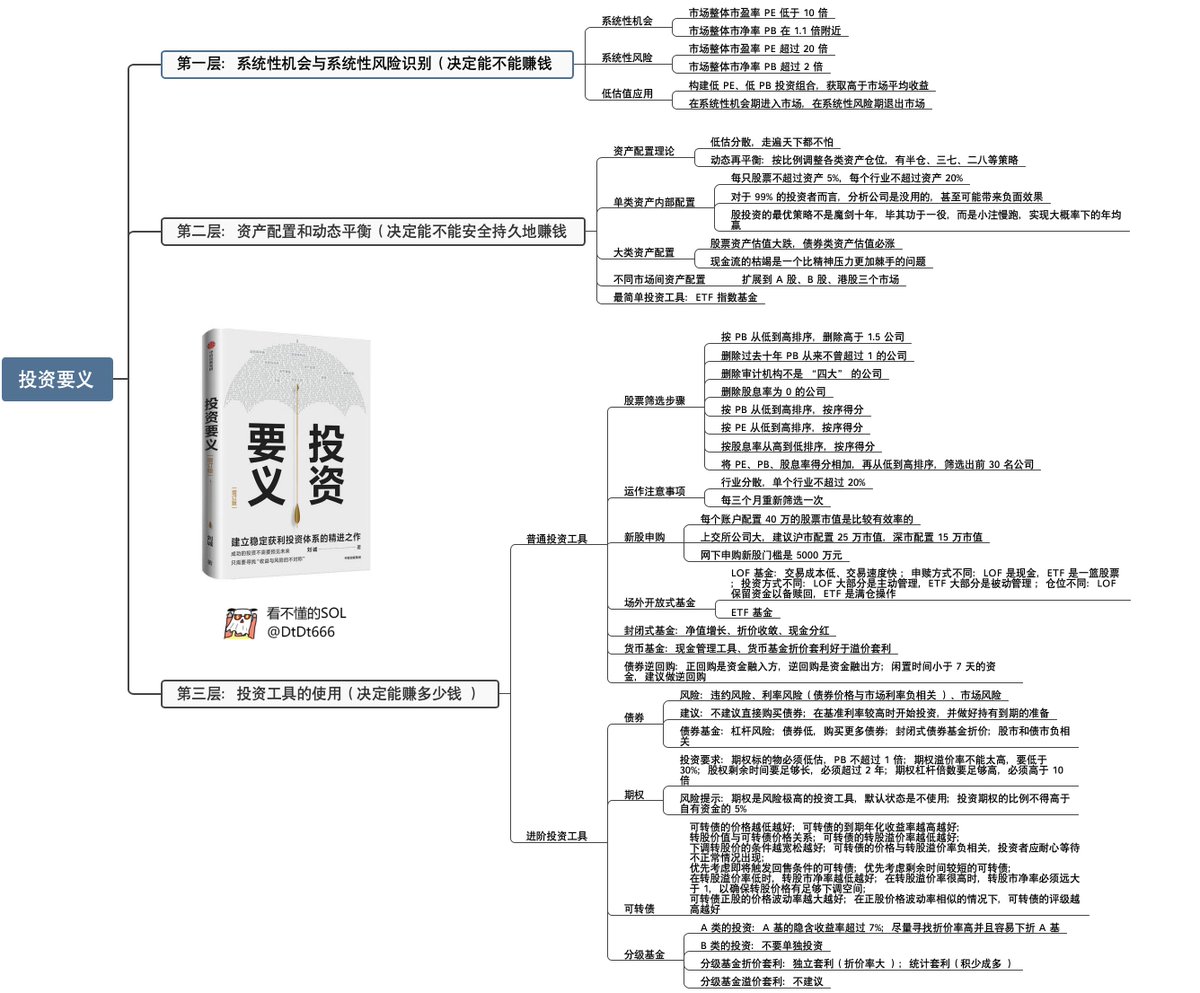After continuing yesterday's article, many brothers asked: Is there a stable financial management path with an annualized rate of 12-18% in the currency circle?
Today, I deliberately worked overtime to sort out an issue (rush work during the holidays, welcome to add!) )
1️⃣ Moderate (low risk):
U.S. bond RWA (such as USDY, USD0) has an annualized rate of 4%-5%, which is suitable for long-term holding.
Exchange current wealth management (such as Binance Earn) 2%-20%+, the head platform is safe.
2️⃣ Yield Enhancement (Medium and High Risk):
Ethena Arbitrage (USDe): 15%-35% annualized, relying on derivatives for hedging, but be wary of negative fee risk.
Pendle Yield Tokenization: 8%-25%+ annualized, flexible trading income rights, suitable for veterans familiar with DeFi.
3️⃣ High Play Option (High Risk):
Option structured products (such as shark fins, etc.) have an annualized rate of 5%-30%+, which requires a certain ability to judge the market.
Alternative staking (e.g., AO network staking DAI) has floating returns and high risk.
💡 Suggested combinations:
Seeking stability: U.S. bond RWA + current wealth management on head exchanges.
Bo income: Ethena arbitrage + Pendle tokenized decentralized allocation.

如你只是想要长期年化赚12%-18%
一本书就够了,《投资要义》。
读了几遍了,有原理有案例,简洁明了,简单易懂。
微信读书就可以免费阅读,连下载都省了。
毫不夸张的说,我媳妇到现在累计盈利100w,这本书有一半的功劳。没有特殊情况的话,不出三五年,她累计盈利就能超过400w。
这本书知道的人并不多,但是只要有人问起,我都会推荐这本,而读过的人无一例外的都回头感谢我。
下面我为兄弟们分享下要点
全书主旨十六个字:
低估分散,股债平衡;
体系严整,工具丰富。
01、体系
「投资体系的三个层级如下。
第一层级:系统性机会与系统性风险的识别。
第二层级:资产配置与动态再平衡。
第三层级:投资工具的使用。
在投资体系的三个层级中,越基础的层级越简单,同时也越重要。
第一层级,决定了我们能不能赚钱;第二层级,决定了我们能不能安全、持久地赚钱;而第三层级,决定了我们能赚多少钱。」
第一层级识别系统性机会与系统性风险,主要是根据估值的高低决定当前投资是回报大于风险还是风险大于回报。
第二层级资产配置与动态平衡是为了分散风险,降低一下子清零的概率。
第三层级是借助不同的投资工具来赚钱,股票、基金、债券或者可转债都可以。
02、低估
股票是否处于低估状态,本书作者主要通过市净率和市盈率进行判断。
「估值,可以参考两个非常简单的指标——市盈率和市净率。
1.市盈率(Price Earnings Ratio,缩写为PE)
计算公式:每股股价÷每股收益,或总市值÷公司年度净利润。
2.市净率(Price Book Value Ratio,缩写为PB)
计算公式:每股股价÷每股净资产,或总市值÷公司当前净资产。」
作者给出了一个简单的指标,市盈率 10 倍以下为低估,20 倍以上为高估;市净率 1 倍以下为低估,2 倍以上为高估。
私以为根据市盈率和市净率判断估值没有问题,但是上面的指标不能通用,行业不同适用的市盈率、市净率高估还是低估的数值也不同。
不过作者关于市盈率和市净率的解读还是挺不错的:
「任何公司的股东想从公司中获得回报,都有且只有两种可行的方式:经营和清算。对于投资者而言,同一家公司有两种评估其价值的视角,即“经营价值”和“清算价值”。
关注经营这家店每年能赚多少钱,这就是市盈率的思维;关注把店卖掉能收回多少钱,这就是市净率的思维。」
买入股票之前可以适当关注一下市盈率、市净率甚至股息率这三个指标,买得便宜,安全边际就大,抗跌能力更强。
投资想要赢,要做到「熊市少跌一点,牛市跟上尽量跟上涨幅」,买入低估股票就能够帮助做到熊市少跌一点。
03、分散
「股票有风险,投资需谨慎」,相信这句话大家都听过,但是股票的风险在哪里呢?
在于单只股票波动非常大,经营不善甚至可能会退市,或者在大 A 这样行业风格轮动非常明显的市场,购买单只股票往往风险很高。
怎么应对。资产配置,分散投资。
股票单个行业不要超过投资总资产 20% ,单只股票不要超过投资总资产 5% ,适当配置债券等进行分散投资,同时定期再平衡,被动实现低买高卖。
资产配置能够降低波动和单个股票退市带来的风险。
购买宽基指数基金也是分散投资的一种,因为宽基指数基金里面会投资不同股票。
04、投资工具
作者书中介绍了股票、指数基金、债券基金以及可转债等投资工具。
股票是否投入自己看好的公司,但是依然是单只股票不要超过总投资资金 5% ,单个行业不要超过 20%。
指数基金适合进行分散投资,不仅是在 A 股的分散投资,还可以通过 QDII 投资海外指数基金,进行投资市场的分散投资。
债券基金波动比较小,配置适当的债券基金可以平衡投资组合的波动,定期再平衡实现低买高卖甚至能够在降低波动的同时带来同样或者更高的收益。
可转债因为有着债和股的属性,因此「下有保底,上不封顶」,这是可转债的最大优势。不过因为这里面还是有出现公司无法偿债的情况,所以下有保底的优势不一定能够兑现。
总的来说,这本书作为投资入门还是很不错的,「低估」与「分散」能够确保一个人投资立于不败之地,另外的就是掌握不同投资工具的属性,选择适合自己的就好了。
共勉!

243.77K
431
The content on this page is provided by third parties. Unless otherwise stated, OKX is not the author of the cited article(s) and does not claim any copyright in the materials. The content is provided for informational purposes only and does not represent the views of OKX. It is not intended to be an endorsement of any kind and should not be considered investment advice or a solicitation to buy or sell digital assets. To the extent generative AI is utilized to provide summaries or other information, such AI generated content may be inaccurate or inconsistent. Please read the linked article for more details and information. OKX is not responsible for content hosted on third party sites. Digital asset holdings, including stablecoins and NFTs, involve a high degree of risk and can fluctuate greatly. You should carefully consider whether trading or holding digital assets is suitable for you in light of your financial condition.

